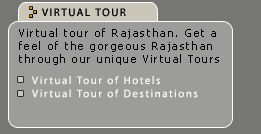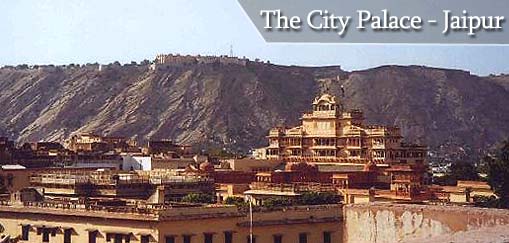 |

|
 |
| |
The
Land of Rich Heritage, Colors and Traditions brings out
the most of regal experiences. Check out the mood of various
Destinations in Rajasthan, most liked and appreciated
by Travelers around the globe. |
|
|
| |
|
| |
|
|
 |
 |
|
|
 |

|
| |
 |
| |
|
 |

|
| |
Lying
in the heart of the city in a sprawling walled endosure
occupying one seventh of the total area comprising
the walled city, the city palace or royal residence
is a blend of the Rajasthani & Mughal Styles by
projected balconies, arches on slender pillars &
ornate entrances. A huge paved courtyard is flanked
on three sides by apartments for the royal retainers
whose families are at hand to serve as guides. The palace
houses the seven-storied Chandra Mahal where the former
ruling family still lives, outer courtyard with Mubarak
Mahal, Diwani-i-Am, Diwan-i-Khas and a museum. The museum
houses a rare collection of fascinating armory
of Rajputs & Mughal weapons, swords of of
all shapes and sizes, some of them inlaid, enamelled,
encrusted with jewels and encased in bold & magnificent
scabbards, textile, carpets, costumes, art objects &
royal paraphernalia. It also has an Art Gallery with
a fine collection of paintings, carpet & rare astronomical
works in Arabic, Persian, Latin & Sanskrit, acquired
by Sawai Jai Singh II for his study of planets &
their movements.
|
|
| |
| |
|
| |

|
| |
One
of the most famous sights in Jaipur is the Hawa Mahal
(The Palace of Winds, 1799), which is in fact not a
palace, but a beautiful façade of pink sandstone with
airy windows.The Hawa Mahal has fensters like these,
because the wifes of the Maharadja used to sit here.
They could look outside and at the same time the whole
palace was cooled down by the wind that went through
the windows. That's why this is called Hawa Mahal /
Or the Palace of the Wind.
|
| |
|
| |

|
|
| |
| |
| |
| |
| |
|
| |
|
| |
|
| |
| |
| |
|
| |
| |
| |

|
| |
|
| |
|
| |
|
|
|
|
| |

|
| |
3 km east
of the city are the remains of the ancient city which
contains some cenotaphs are in Jain style and set on
high plinths. The museum has some very old earthen pottery,
sculptures & other historical artefacts. The full-length
exquisitely carved statue of Sawai Jai Singh in white
marble in the centre of the circle was erected under
the newly planned scheme area to pay homage to the founder
of Jaipur.
|
| |

Beautifully landscaped gardens, laid out in the 18th and
19th century by kings and courtiers dot the narrow gorge
in the south eastern corner of the walled city, along
the road to Agra. Sisodia Rani garden has tiered multilevel
gardens with fountains, water channel and painted pavilions
and suites of living rooms. Amongst others, Vidyadhar-ka-Bagh
is the best preserved one, with shady trees, flowing water,
an open pavilion. It was built by the planner of the city,
Vidyadhar.
|
|
| |
|
|